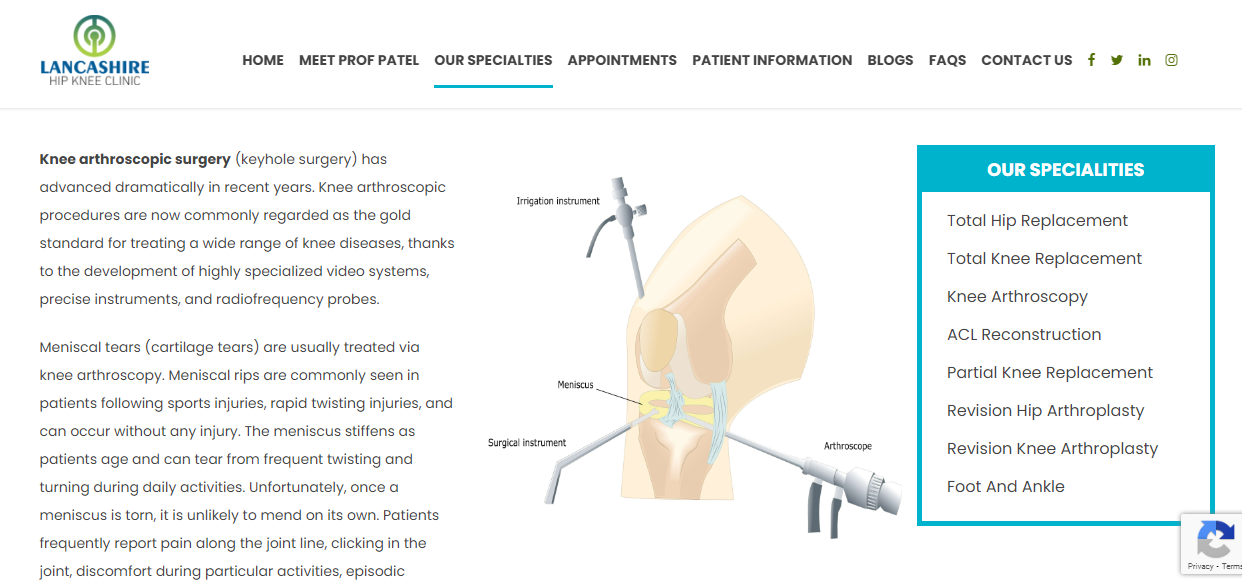Understanding Knee & Joint Arthroscopic Surgery: Procedure, Recovery, and Expectations

Strong 8k brings an ultra-HD IPTV experience to your living room and your pocket.
Knee and joint arthroscopic surgery has emerged as a significant advancement in orthopedic medicine, offering minimally invasive solutions to a range of joint-related issues. This surgical technique has revolutionized the treatment landscape for conditions such as torn ligaments, damaged cartilage, and other joint injuries. In this comprehensive guide, we delve into the intricacies of knee and joint arthroscopic surgery, covering the procedure itself, the recovery process, and setting realistic expectations for patients undergoing this treatment.
Understanding the Procedure:
Arthroscopic surgery involves the use of a tiny camera, known as an arthroscope, which is inserted into the joint through small incisions. This camera provides a high-definition view of the interior of the joint, allowing the surgeon to visualize the problem areas without the need for large incisions. Alongside the arthroscope, specialized surgical instruments are used to repair or treat the underlying issue.
The procedure typically begins with the administration of anesthesia, either general or regional, to ensure the patient's comfort throughout the surgery. Once the anesthesia takes effect, small incisions, typically less than a centimeter in size, are made around the joint. Through these incisions, the arthroscope and surgical instruments are inserted.
Inside the joint, the surgeon carefully examines the structures, identifying any abnormalities or damage. Depending on the specific condition, various techniques may be employed during the procedure. For instance, torn ligaments may be repaired using sutures or anchors, while damaged cartilage may be trimmed or smoothed out to restore functionality.
One of the key advantages of arthroscopic surgery is its minimally invasive nature, resulting in reduced trauma to the surrounding tissues, less post-operative pain, and faster recovery times compared to traditional open surgery.
Recovery Process:
Following knee and joint arthroscopic surgery, the recovery process plays a crucial role in achieving optimal outcomes. While the procedure itself is minimally invasive, proper post-operative care is essential to promote healing and restore joint function.
Immediately after the surgery, patients are typically monitored in a recovery area until the effects of anesthesia wear off. Depending on the complexity of the procedure and individual patient factors, some individuals may be discharged home on the same day, while others may require a short hospital stay for observation.
During the initial phase of recovery, patients are advised to rest and elevate the affected limb to reduce swelling. Pain management strategies, including medications prescribed by the surgeon, may be utilized to keep discomfort at bay. Additionally, physical therapy exercises are often introduced early on to promote joint mobility and prevent stiffness.
As the days and weeks progress, patients gradually increase their activity levels under the guidance of their healthcare team. Physical therapy sessions play a crucial role in this phase, focusing on strengthening the muscles surrounding the joint, improving range of motion, and restoring functional abilities.
It's important for patients to adhere to their prescribed rehabilitation regimen diligently, as consistency and commitment are key to achieving optimal outcomes. While each individual's recovery timeline may vary based on factors such as the extent of the injury and overall health status, most patients can expect to resume normal activities within a few weeks to several months following surgery.
Setting Expectations:
Setting realistic expectations is paramount for patients considering knee and joint arthroscopic surgery. While this innovative procedure offers numerous benefits, it's essential to understand that it may not be suitable for every condition or individual.
First and foremost, patients should have a thorough discussion with their orthopedic surgeon to determine whether arthroscopic surgery is the most appropriate treatment option for their specific situation. Factors such as the severity of the injury, underlying medical conditions, and overall health status will be taken into account during this evaluation process.
It's important to recognize that while arthroscopic surgery can effectively address many joint issues, it may not always result in a complete resolution of symptoms. Some individuals may experience residual pain or limitations in joint function following surgery, particularly in cases of advanced arthritis or irreparable damage.
Additionally, like any surgical procedure, knee and joint arthroscopic surgery carries inherent risks and potential complications, albeit relatively rare. These may include infection, blood clots, nerve damage, or failure to achieve the desired outcome. Patients should be fully informed of these risks and have realistic expectations regarding the potential benefits and limitations of the procedure.
Conclusion:
In conclusion, knee and joint arthroscopic surgery represents a significant advancement in orthopedic medicine, offering minimally invasive solutions to a variety of joint-related issues. By understanding the procedure itself, the recovery process, and setting realistic expectations, patients can make informed decisions about their treatment options and approach the surgical journey with confidence.
As with any medical procedure, open communication with healthcare providers, diligent adherence to post-operative instructions, and a commitment to rehabilitation are essential components of a successful outcome. By working closely with their orthopedic team, patients can optimize their recovery and regain function, allowing them to return to the activities they love with improved joint health and mobility.
Note: IndiBlogHub features both user-submitted and editorial content. We do not verify third-party contributions. Read our Disclaimer and Privacy Policyfor details.


